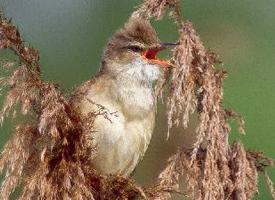
Weights and measures
| Length | from 17 to 20 cm |
|---|---|
| Weight | from 28 to 38 g |
| Wingspan | from 24 to 26 cm |
State of endangerment
| Endangered |
Animal description
The Great Reed Warbler (Acrocephalus arundinaceus) is a captivating species of bird belonging to the family Acrocephalidae, known for its melodious song and striking presence within its natural habitat. This bird is distinguished by its relatively large size compared to other members of the Acrocephalus genus, making it one of the most impressive sights among reed-dwelling warblers.Physical Description:
The Great Reed Warbler is a robust bird, typically measuring between 16 to 20 centimeters in length, with a wingspan ranging from 22 to 30 centimeters. It exhibits a somewhat elongated body, with a strong and straight bill that is ideal for its insectivorous diet. The plumage is predominantly a warm brown color on the upper parts, blending seamlessly into a more subdued and paler brown on the underparts. Its throat and breast may exhibit a faintly streaked appearance, and there is often a distinct contrast between the pale underbelly and the darker tail and wings. The bird's eyes are a piercing dark hue, surrounded by a faintly lighter ring, giving it a vigilant appearance.
Habitat and Distribution:
The Great Reed Warbler is a bird of wetland habitats, thriving in dense reed beds that border lakes, rivers, and swamps. It has a broad geographic range, breeding across Europe and the temperate and subtropical regions of Asia. With the approach of winter, it migrates to sub-Saharan Africa, showcasing an incredible journey that highlights its endurance and adaptability.
Behavior and Diet:
This species is known for its remarkable vocal abilities. The male Great Reed Warbler's song is a loud, varied, and sometimes harsh series of notes and trills, performed with gusto from a prominent perch within its territory. This vocal performance plays a crucial role in attracting a mate and warding off rivals. When it comes to diet, the Great Reed Warbler is predominantly insectivorous, feeding on a variety of insects and other small invertebrates. It adeptly navigates through reeds to catch prey, demonstrating agility and precision.
Reproduction:
The breeding season is a time of intense activity for the Great Reed Warbler. The male establishes a territory, attracting a female with his song. The nest, an intricate structure, is woven among the reeds, suspended above the water. The female lays between 3 to 6 eggs, which are incubated for about two weeks. Both parents are involved in feeding the young, which fledge approximately two weeks after hatching. This period is a critical time, as the young are vulnerable to predators and must quickly learn to navigate their environment.
Conservation Status:
Currently, the Great Reed Warbler is classified as Least Concern by the International Union for Conservation of Nature (IUCN), indicating that it is not presently at significant risk of extinction. However, like many species, it faces threats from habitat destruction and degradation, particularly in wetland areas. Conservation efforts focused on preserving natural habitats are crucial for ensuring the long-term survival of this and many other species dependent on wetland ecosystems.
In conclusion, the Great Reed Warbler is a fascinating bird, not only because of its impressive size and song but also due to its adaptability and the role it plays in the ecosystem. Its presence signifies healthy wetland habitats, which are vital for the biodiversity of our planet.
Similar Animals
New photos of animals
Top 10 animals
- Common cockchafer (Melolontha melolontha)
- Common house mosquito (Culex pipiens)
- Colossal squid (Mesonychoteuthis hamiltoni)
- Fruit fly (Drosophila melanogaster)
- Australian box jelly (Chironex fleckeri)
- Common reed warbler (Acrocephalus scirpaceus)
- Hooded merganser (Lophodytes cucullatus)
- Elephant hawk moth (Deilephila elpenor)
- Moustached guenon (Cercopithecus cephus)
- Diana monkey (Cercopithecus diana)


